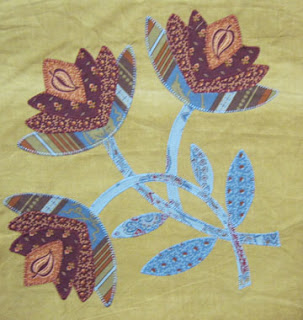Bird in a Cherry Tree
Appliqued by Klonda Holt & Edie McGinnis.
Quilted by Brenda Butcher. 2011.
This fabulous reproduction is in Edie McGinnis's new pattern book from the Kansas City Star.
Confederates in the Cornfield
The book tells the story of a guerilla raid into the Union state of Iowa during the Civil War.
Klonda and Edie named the featured quilt after the birds in the border--- a terrific example of that style of birds and berries (lotsa berries).
See more about Edie's book and a preview by clicking here
The block is one of the fad quilts of the mid 19th century. Many examples of this design were made, usually as repeat blocks, rather than being featured in samplers.
There are variations, something you'd expect in a pattern handed around quilter to quilter. The basic characteristics are a center floral with two different motifs rotating around the center.
One is a stem with fruit, the other a leaf or bud extending into the block's corners.
I show nine variations in my Encyclopedia of Applique on page 84. Names given to the design include Flowering Almond from Comfort magazine in the early 20th century. This is the earliest published name from a pattern source I've found. It's a name that was still used in Tennessee in the 1980s when Bets Ramsey and Merikay Waldvogel did the Tennessee Quilt Project.
I have a flowering almond bush in my yard. It puts out a lot of small flowers on a leafless branch in the spring, looking very much like those rotating arms in the quilt pattern. I found a reference to the name Flowering Almond in a letter from 1860, in which Elizabeth Nessly Myer described such a quilt that was left to her family. (Mill Creek Journal, Kay Atwood editor and publisher, Ashland, Oregon, 1987)
Other names found in print in the early 20th century are Currants & Cockscombs in Marie Webster's book Quilts (1915) and Poinsettia in Ruth Finley's Old Patchwork Quilts (1929).

Once you notice this old design you find it over and over.

















































